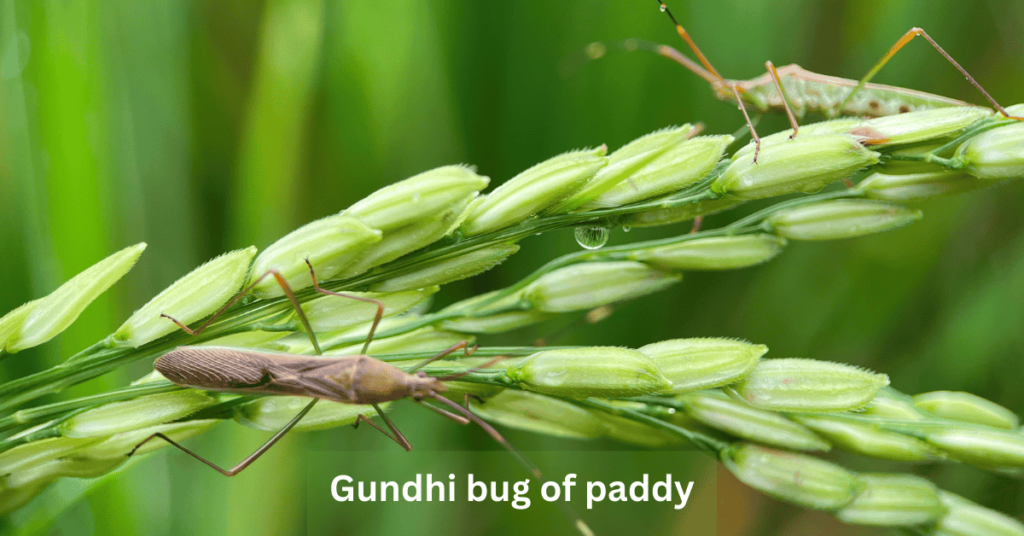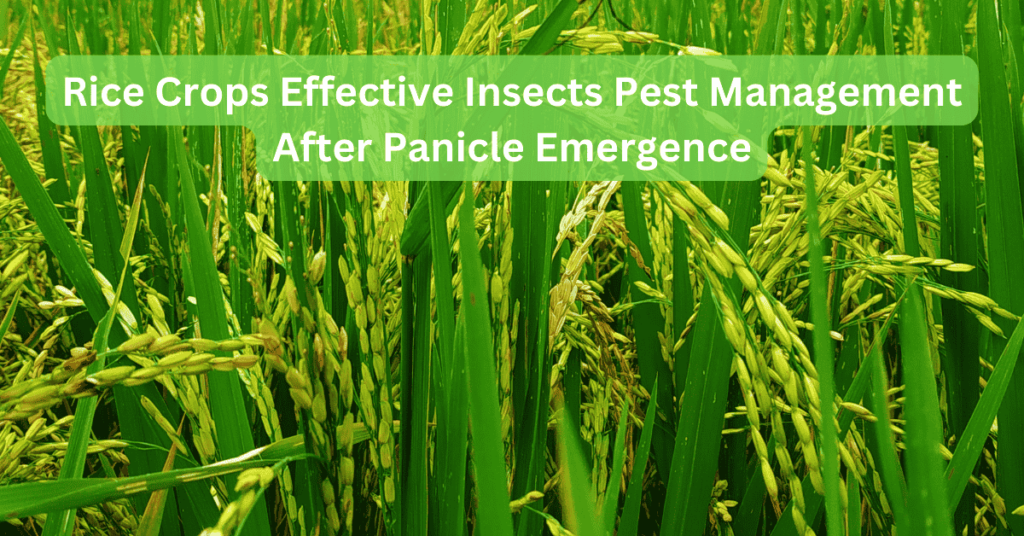After the ear (panicle) emergence stage in rice, the crop becomes susceptible to a range of rice insect pests that can cause significant damage, impacting both yield and grain quality. Effective rice insect pests management during this critical growth phase is essential to avoid severe economic losses.
Here’s a guide to managing common pests that attack rice after ear emergence:
Key Rice Insect Pests After Ear Emergence:
- Rice Gundhi Bug (Leptocorisa acuta)
- Rice Stem Borers (especially at the reproductive stage)
- Rice Hispa
- Armyworm
- Panicle Mite
Rice Insect Pests Management Strategies:
1. Cultural Control
- Timely Harvesting: Early harvesting can help minimize losses from pests like Gundhi bug, which attack the ripening grains.
- Water Management: Maintain proper water levels in the field as some pests (like stem borers) may thrive in overly dry or wet conditions.
- Field Sanitation: Remove weeds, especially grasses in and around the field, as they can harbor pests like earhead bugs.
- Synchronous Planting: Encouraging uniform planting times in a region can help disrupt the life cycles of pests like Gundhi bugs and stem borers.
- Removal of Infested Panicles: Manually remove and destroy heavily infested panicles if pest numbers are high.
2. Biological Control
- Natural Predators: Encourage beneficial insects like spiders, wasps, and ants that feed on rice pests.
- Parasitoids: Release egg parasitoids like Trichogramma to control stem borer populations.
- Biopesticides: Use neem-based formulations or Bacillus thuringiensis (Bt) to manage pests, especially in early infestations.
3. Mechanical Control
- Light Traps and Pheromone Traps: Set up light traps to capture nocturnal pests such as earhead bugs. Pheromone traps can be effective against stem borers.
- Netting: Use nets or other physical barriers to protect the crop from sucking pests like Gundhi bugs.
4. Chemical Control
- Insecticides for Specific Pests:
- Gundhi Bug: Spray systemic insecticides like imidacloprid or acephate when adult populations exceed the economic threshold level (ETL). ETL for Gundhi bug is usually 5-10 bugs per square meter.
- Earhead Bug: Use insecticides if infestations are severe.
- Rice Stem Borers: Apply insecticides such as carbofuran or chlorantraniliprole to manage larvae, especially if whiteheads appear in the panicle.
- Granular Formulations: Use granular insecticides, such as fipronil or carbofuran, for more persistent and slow-release action.
- Pesticide Rotation: Rotate pesticides to avoid the development of resistance in pest populations.
5. Integrated Pest Management (IPM)
- Monitoring: Regularly monitor pest populations to detect early signs of infestation. Pheromone and light traps can assist in determining pest pressure.
- Threshold Levels: Only apply pesticides when pests surpass economic threshold levels to avoid unnecessary chemical applications.
- Use of Resistant Varieties: Select rice varieties that have some resistance to pests, especially stem borers and panicle feeders.
Specific Rice Insect Pests Management:
1. Gundhi Bug

- Damage: It sucks sap from the grains, leading to unfilled or poorly developed grains (chalky grains).
- Symptoms: Discolored, shriveled grains, incomplete grain filling
- Management: Spray Thiamethoxam 75% SG @60-100 gm/acre or Thiamethoxam 25% WG @100gm/acre in 150-200 liters of water or neem oil-based insecticides when pest populations rise. Avoid excessive nitrogen fertilization as it makes the crop more attractive to the bugs.
2. Rice Stem Borer
- Damage: The larvae Rice Stem Borer bore into the stem, causing “whiteheads” during the panicle stage, which results in unfilled panicles.
- Symptoms: Presence of white, empty panicles
- Management: If whiteheads are detected, Spray Cartap Hydrochloride 50% SP: 300-400 gm/acre in or Chlorantraniliprole 18.5% SC 60 ml/acre in150-200 liters of water or release egg parasitoids like Trichogramma.
3. Panicle Mite
- Damage: These mites feed on the developing grains, leading to shriveled or empty grains.
- Symptoms: Shrivelled, empty grains in affected panicles
- Management: Spray acaricides like abamectin if mite populations are high.
Conclusion:
Effective rice insect pests management in rice after ear emergence involves a combination of timely monitoring, cultural practices, biological controls, and judicious use of chemical pesticides. Integrated Pest Management (IPM) remains the best approach to minimize crop damage and ensure environmental sustainability.
How helpful was this post for you, tell me in the comment box and you can also give us your advice, your comments and advice are very important to us.
Thank you..!
